
Double Crown for the CCNY SPS Chapter
The National Council of the Society of Physics Students (SPS) designated the City College of New York (CCNY) chapter a SPS Outstanding Chapter. This is the highest level of distinction that SPS bestows upon the chapters and less than 10% of the top chapters receive the honor annually. Only 77 of 813 chapters received this honor in 2018.
Earlier, members of the SPS National Council chose the CCNY chapter for the 2018 Blake Lilly Prize. The Prize, “named after the late Blake Lilly and given in his honor, recognizes SPS chapters and individuals who make a genuine effort to positively influence the attitudes of school children and the general public about physics.” The letter communicating the award to the CCNY Physics Club president, Lisa Chan, stated, “Reviewers noted the quality of your chapter’s science outreach activities and were impressed with the reach and scope of your efforts.”
 The selection is based on engagement with national SPS programs, the professional physics community and the campus community, as well as outreach to K-12 grade students, public outreach, community service and contributions to student recruitment and retention. The activities of the CCNY Chapter were detailed in a report that the Chapter submitted to the SPS National Council. The report was prepared by Ethan Bendau (Undergraduate Club President) and Veeshan Narinesingh (Graduate Club President and Outreach Coordinator) under the supervision of Professor Sebastian Franco, the Chapter Adviser.
The selection is based on engagement with national SPS programs, the professional physics community and the campus community, as well as outreach to K-12 grade students, public outreach, community service and contributions to student recruitment and retention. The activities of the CCNY Chapter were detailed in a report that the Chapter submitted to the SPS National Council. The report was prepared by Ethan Bendau (Undergraduate Club President) and Veeshan Narinesingh (Graduate Club President and Outreach Coordinator) under the supervision of Professor Sebastian Franco, the Chapter Adviser.
The highlights of CCNY Chapter’s 2018 activities include helping organize the activities of the Physics Major’s Month, organizing Amateur Astronomy Nights, hosting the Career Opportunity Fair and the Research Opportunity Fair, SPS Membership Promotion, tutoring 8th graders from Hamilton Grange Middle School to prepare for New York State’s standardized testing and presenting hands-on physics demonstrations for K-12 students from underrepresented communities.
The Planetarium Comes Alive
The addition of a new digital projection system enables the CCNY Planetarium to have regular shows after a period of inactivity. The planetarium hosted a group of astrobiology students from LaGuardia Community College on October 18, 2018. Their instructor, Professor Joshua Tan gave a stunning tour of some of the interesting locations on Mars.
On October 22, we had an all-day Open House with five separate shows – three live tours of the cosmos and two full dome movie viewings. Both events were delightful and fulfilled their intended functions: (a) to let people know about the planetarium and its potential; and (b) to work out many of the little hiccups and kinks that are bound to crop up when doing public events in the planetarium and (c) to show the denizens of our light polluted city the beauty of the cosmos!
 The space shows started by virtually visiting the CCNY campus, then taking off and examining the view of earth from the height of the International Space Station (~250 miles). Then we explored the moon, making a stop at the Copernicus Crater. Mars, also on the itinerary, featured vistas from a pit in the Noctis Labyrinthus region of the Mariner Valley. After Mars, the audience chose where to head next, usually Saturn or Jupiter. After looking at the solar system as a whole, an exceedingly quick trip to the intergalactic regions and the Sloan Digital Sky Survey concluded our quite memorable space journey.
The space shows started by virtually visiting the CCNY campus, then taking off and examining the view of earth from the height of the International Space Station (~250 miles). Then we explored the moon, making a stop at the Copernicus Crater. Mars, also on the itinerary, featured vistas from a pit in the Noctis Labyrinthus region of the Mariner Valley. After Mars, the audience chose where to head next, usually Saturn or Jupiter. After looking at the solar system as a whole, an exceedingly quick trip to the intergalactic regions and the Sloan Digital Sky Survey concluded our quite memorable space journey.
Based on audience engagement during the shows and from the perspective of the operators, we can say we are ready to start taking regular trips to the Moon, Mars, Mercury, and beyond - all from the comfort of the planetarium at the CCNY Marshak Building.
(Contributed by James Hedberg, Director, CCNY Planetarium)
Feynman’s Legacy:
Reminiscences from his last year
Alexios Polychronakos
This year marks the 100th anniversary of the birth of Richard Feynman, an iconic figure in 20th century science. Feynman dominated theoretical physics with his creativity, insights and style. But he also projected a sense of excitement about science and life in general, a kind of joie de vivre that was infectious. A great teacher and communicator, he charmed audiences with his quick-witted, pseudo-naive, no-nonsense chatter. In all, Feynman single-handedly created the image of the playful, irreverent physicist relying heavily on his smarts and intuition, and achieved cult status well beyond the physics community - sometimes to the exasperation of his peers!
I interacted with Feynman during what was to be his last year of life and my last year of graduate studies at Caltech. I was left with fond memories of exciting conversations, a bittersweet longing for the person, and some of his personal notes and manuscripts. I would like to share some of these memories and give a glimpse of Feynman’s personality as experienced in my 1980s Caltech years
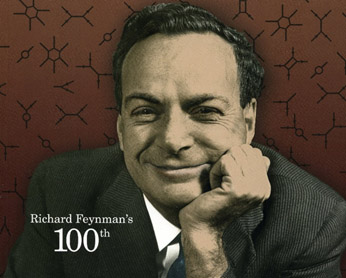 I started my journey in Caltech as a somewhat dazzled EE major from Greece transiting into physics. Among the Pleiades of past and future local legends, which included Gell-Mann, Thorne, Politzer, Fowler and Barish, Feynman was the brightest star. At the time, however, he was mostly interested in quantum computation, a topic he pioneered, so he was out of the mainstream physics teaching circuit. He taught a course on complexity and quantum limitations in computing, consisting of some lectures by himself and seminars by invited guests. I took the course. In early 1986 the Challenger disaster happened, and he became part of the investigation panel, leading to some interesting stories.
I started my journey in Caltech as a somewhat dazzled EE major from Greece transiting into physics. Among the Pleiades of past and future local legends, which included Gell-Mann, Thorne, Politzer, Fowler and Barish, Feynman was the brightest star. At the time, however, he was mostly interested in quantum computation, a topic he pioneered, so he was out of the mainstream physics teaching circuit. He taught a course on complexity and quantum limitations in computing, consisting of some lectures by himself and seminars by invited guests. I took the course. In early 1986 the Challenger disaster happened, and he became part of the investigation panel, leading to some interesting stories.
In the summer of 1986 Feynman had a recurrence of his cancer and had to undergo therapy, which kept him out of campus for most of the fall. When he recovered, he felt like he wanted to learn something new. So he turned to a subject spearheaded by one of his heroes, Hans Bethe: integrable models and the Bethe Ansatz. He read, learned, absorbed and digested the material, and was ready to give it his own spin and intuition and enjoy it in his preferred way: by teaching it.
He gave a set of two seminars where he exposed everything he knew about the subject in his inimitable way and described some of his ideas and hopes on where integrability might prove fruitful: QCD fragmentation, solving gauge theories by identifying “good” variables like in integrable models. He invited students interested in the subject to meet with him regularly and discuss, and often went with them to lunch at the student cafeteria, the infamous Chandler. Many of us flocked, out of curiosity, compulsion or interest. I remember Michael Douglas, Olivier Espinosa, Arun Gupta, Sandip Trivedi; maybe others too.
Initially I was hesitant to join: I had had the temerity and naiveté to contradict him on a minor point in a seminar (I don't remember by whom) and was scared to show my face. Until Sandip told me "Feynman is asking for you. He says `where is this guy who talked at the seminar? I want to talk to him’ ".
I went to see him, timidly, and he said: "You were damn right about that thing. You know, it wasn't the first time I was wrong about something. Would you like to come chat with us?" I became part of the regular meetings after that. It was spring of 1986.
The current topic was the inverse-square model (what we now call the Calogero model). Feynman was fascinated by its many interesting properties (its “surprises” he would say) and wanted to explore it more. He had read a review by Sutherland and communicated with him by mail. Sutherland was of course overjoyed to respond and send him more of his papers. Feynman wanted to find an intuitive proof of the model's integrability. In this, he came up with a field theory-based proof (and, of course, his own notation!) which he described to us. He sent his proof to Sutherland with the comment, "I am disappointed in the proof [...] I learn nothing, no real clue as to why all this works, and what it means."
In the course of this I contributed some of my first ideas on the topic (an extension to non-conserved quantities that are triangular under time evolution closing to the integrals of motion, which evolved into a matrix formulation). Feynman liked the work and had fun doing explicit calculations. He was not a man who was afraid to “dirty his hands”. His calculations were detailed, well set up and efficient, and he obviously relished them. He sent a couple more letters to Sutherland relating our work, and ending with some (rhetorical) questions and a statement: “Don't tell us - we are having fun - that is why we haven't looked at your papers yet. Just tell us if any of this is unknown.”
We chatted about this and other things, often over lunch at the faculty club, the classy Athenaeum. Talking with Feynman was easy, even for a lowly grad student like me. He had a boyish curiosity and enthusiasm about things that could be considered almost naïve, if past history had not demonstrated how quickly they could evolve into groundbreaking and nontrivial insights. An example:
RF: “I was listening to the radio yesterday, to a program in Persian. Do you speak Persian?”
AP: “No, I don't.”
RF: “Isn’t Greek similar to Persian?”
AP: “Actually no, they are quite distinct.”
RF: “Anyway, I was trying to guess what they were talking about from the pattern of the talk. For instance, they kept repeating something like “shaha shahee shaha...” and I figured this must be the area code of their phone number. So “shahee” must stand for the middle digit, which is usually 1. If I can figure what area code they are in I can start making the words for the numbers...”
No point, of course, looking into a Persian dictionary or asking a Persian speaker. What would be the fun in that?!
On the other hand, he was impatient with high-browed mathematics and pompous language. An example: I mentioned to him that the triangular quantities I introduced in the Calogero model closed to an algebra that did not involve explicitly the coupling constant, and so the Calogero model must be among its representations (this is known now as the W-algebra). His response (in mocking oratory style): "Gee, listen to him, isn't he a great man? He talks about algebras!" That was the end of it!
I was almost sad when I had to take up my first postdoctoral position in 1987. I was leaving behind the excitement of talking to a great physicist, which was also genuinely fun. The kind of fun that makes you look forward to the next topic and the next discussion, even if you know nothing of “practical” value (“paperizable”) would come out of it.
I kept working, on the side, on the inverse-square model during the fall of 1987 (the fractional statistics interpretation and the first realization of exchange operators came then). I was eager to relate my results to Feynman, and I visited Caltech during the winter break of 1987-88. I saw him once. He was again fighting a recurrence of his cancer and was quite weak. Yet he came to the office and we talked about integrable models for one last time. His voice had lost its irreverent announcer-like tenor, but retained a tingle of playful mockery tempered by gentleness.
Soon after that he was taken to the hospital for an aggressive new treatment. His kidneys failed, and he went under dialysis. Feynman knew when to fight, but also when it was not worth fighting anymore. So he asked to be taken off dialysis and proceed to the end. In this last stretch, unable to engage in anything creative, he famously said “I'd hate to die twice - it's so boring”.
He passed away on February 15, 1988.
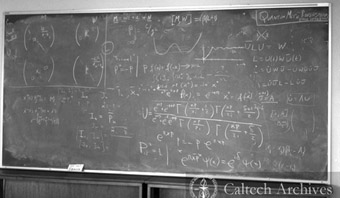 When I visited Caltech again in the summer of 1988, Feynman's secretary, the late Helen Tuck, gave me a folder with his notes on the things we were doing together (some of these I shared in a talk I gave at City College on October 10). The February 1989 issue of Physics Today was dedicated to Feynman and included a picture of his last blackboards, which were taken down and stored. I was surprised to see that they were as we left them the day of our meeting, with many of the things we discussed still on them.
When I visited Caltech again in the summer of 1988, Feynman's secretary, the late Helen Tuck, gave me a folder with his notes on the things we were doing together (some of these I shared in a talk I gave at City College on October 10). The February 1989 issue of Physics Today was dedicated to Feynman and included a picture of his last blackboards, which were taken down and stored. I was surprised to see that they were as we left them the day of our meeting, with many of the things we discussed still on them.
When I talk about Feynman with senior people who knew him well, they often tell what a difficult and sometimes terrifying personality he was in his earlier years. They relate how he would deride people, attack speakers, and how he suppressed some of his colleagues to a point that they could never recover scientifically. I am discomforted by these stories; yet I have seen myself glimpses of that side of him and know they are true. Still, I prefer to remember him as the gentle, fun person I came to know in that last year of his life, realizing full well that this was a small cross-sectional slice of a much bigger life and character.
This, I believe, is what makes Feynman's legacy valuable: He was not great because he was perfect, or unerring, or generous. He was great because, for all his human flaws, he contributed to science as few others have, and conveyed through his example and his personality one priceless lesson: physics, science and life can and should be fun, and they must be lived fully. Until the very end.
Sean Carroll Delivers the Cosloy-Blank Lecture
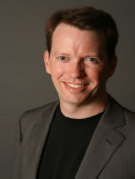 The Fourth Annual Sharon Cosloy – Edward Blank Family Distinguished Scientist Lecture was delivered on Wednesday October 17, 2018 by Dr. Sean Carroll of California Institute of Technology (Caltech). Sean Carroll is a theoretical physicist at Caltech with research interest in theoretical aspects of cosmology, field theory, gravitation, and quantum mechanics. He is also a prolific communicator of science to the general public. The popular-level books he has written include: From Eternity to Here: The Quest for the Ultimate Theory of Time; The Particle at the End of the Universe: How the Hunt for the Higgs Boson Leads Us to the Edge of a New World; and The Big Picture: On the Origins of Life, Meaning and the Universe Itself. He also wrote a graduate textbook, Spacetime and Geometry: An Introduction to General Relativity, and recorded lectures for the Teaching Company on Dark Matter and Dark Energy and the Mysteries of Time. He has written for Discover, Scientific American, New Scientist, Sky & Telescope, and other publications. His blog Cosmic Variance that features a wide range of topical commentary and ideas is hosted by Discover magazine. He also has a podcast, titled Mindscape.
The Fourth Annual Sharon Cosloy – Edward Blank Family Distinguished Scientist Lecture was delivered on Wednesday October 17, 2018 by Dr. Sean Carroll of California Institute of Technology (Caltech). Sean Carroll is a theoretical physicist at Caltech with research interest in theoretical aspects of cosmology, field theory, gravitation, and quantum mechanics. He is also a prolific communicator of science to the general public. The popular-level books he has written include: From Eternity to Here: The Quest for the Ultimate Theory of Time; The Particle at the End of the Universe: How the Hunt for the Higgs Boson Leads Us to the Edge of a New World; and The Big Picture: On the Origins of Life, Meaning and the Universe Itself. He also wrote a graduate textbook, Spacetime and Geometry: An Introduction to General Relativity, and recorded lectures for the Teaching Company on Dark Matter and Dark Energy and the Mysteries of Time. He has written for Discover, Scientific American, New Scientist, Sky & Telescope, and other publications. His blog Cosmic Variance that features a wide range of topical commentary and ideas is hosted by Discover magazine. He also has a podcast, titled Mindscape.
The fourth Cosloy-Blank Lecture, “Our Preposterous Universe” was a public lecture delivered in the North Academic Center. CCNY President Vincent Boudreau made welcoming remarks and then introduced Provost Tony Liss. Provost Liss introduced Dr. Carroll. Following the lecture, Dr. Carroll took questions from the audience. Guests attending the lectures also had an opportunity to ask questions and exchange ideas with Dr. Carroll during the reception that followed. Dr. Carroll also presented another more technical talk, “Extracting the Universe from the Wave Function” on Thursday, October 18, 2018 at the Physics Department. In this talk he discussed the recent progress in deriving features, such as classical space-time, locality, preferred observables, the system/environment split, collapse/branching, Born rule of probability from the basic ingredients of the quantum state and the Hamiltonian. During his two days at CCNY, Dr. Carroll also had one-on-one conversations with interested faculty members, a meeting with a group of students, and had lunch with the students.
The Cosloy-Blank lecture, considered to be the preeminent scientific lecture on the CCNY campus, is organized by the CCNY Division of Science with support from an endowment established by Mr. Edward Blank (CCNY Class of 1957) in honor of his late wife Sharon Cosloy. Professor Cosloy was a member of the City College Biology Faculty for 27 years and Chair of the Department for six years. She is remembered as a beloved mentor, educator, wife, mother and a passionate investigator of life and science. Her area of research interest and expertise was in prokaryotic genetics. The three previous Cosloy-Blank lectures were presented by Nobel Laureate Dr. John O’Keefe (The Hippocampus as Cognitive Map: How We Got Here and Where We Are Going); Dr. Persi Diaconis (The Search for Randomness) and Dr. Susan Solomon (A Brief History of Environmental Successes).
Angel Rubio Presents the Zemansky Lecture
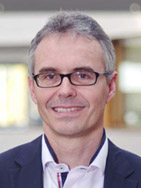 Dr. Angel Rubio presented the 2018 Mark Zemansky Lecture in Physics, “Photons and Matter Cooperate: New States of Matter from a Novel First Principles QEDFT Formalism” on November 14, 2018 at the Advanced Science Research Center (ASRC) auditorium. Dr. Rubio is the Director of the Theory Department of the Max Plank Institute for Structure and Dynamics of Matter at Hamburg, Group Leader of the Nano-Bio Spectroscopy group in San Sebastián, Distinguished Professor at the Materials Science Department UPV /EHU, San Sebastián; Vice-president for Scientific Development of European Theoretical Spectroscopy Facility (ETSF); and External Scientific Member of the Fritz Haber Institut (FHI) der Max-Planck-Gesellschaft, Berlin.
Dr. Angel Rubio presented the 2018 Mark Zemansky Lecture in Physics, “Photons and Matter Cooperate: New States of Matter from a Novel First Principles QEDFT Formalism” on November 14, 2018 at the Advanced Science Research Center (ASRC) auditorium. Dr. Rubio is the Director of the Theory Department of the Max Plank Institute for Structure and Dynamics of Matter at Hamburg, Group Leader of the Nano-Bio Spectroscopy group in San Sebastián, Distinguished Professor at the Materials Science Department UPV /EHU, San Sebastián; Vice-president for Scientific Development of European Theoretical Spectroscopy Facility (ETSF); and External Scientific Member of the Fritz Haber Institut (FHI) der Max-Planck-Gesellschaft, Berlin.
In his lecture, Dr. Rubio first reviewed the recent experiments at the interface between materials science and quantum optics that uncovered situations where both the molecular system and the photon field have to be treated in detail. He then went on to show how the effects of quantum-photons can be properly included in the newly developed quantum electrodynamics density-functional formalism (QED-TDDFT). He provided an overview of how well-established concepts in the fields of quantum chemistry and material sciences have to be adapted when the quantum nature of light becomes important in correlated matter-photon problems.
The lecture is named after Dr. Mark Waldo Zemansky (May 5, 1900 – December 29, 1981), a professor of physics at CCNY from 1925 to 1967 and Chair of the Physics Department from 1956 to 1959. His research encompassed resonance radiation and excited atoms, radiation and collision processes of gaseous atoms, and low-temperature measurement of heat capacities of superconducting metals. He was involved in Chien-Shiung Wu’s groundbreaking experiment in which the violation of parity conservation in weak interactions was established. Zemansky is best known for co-authoring University Physics, an introductory physics textbook, with Francis Sears. The book, first published in 1949, is still widely used and is currently referred to as Sears and Zemansky’s University Physics with Hugh Young, Roger Freedman and A. Lewis Ford as co-authors. In addition to the Zemansky Lecture, CCNY has a Zemansky Chair (currently held by Professor Michael S. Lubell), and presents the Zemansky Introductory Physics Prize that recognizes outstanding scholarship in Introductory University Physics courses.
Glennys Farrar delivers the Semat Lecture
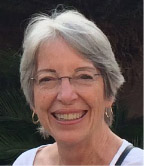 Dr. Glennys Farrar, Professor of Physics and Collegiate Professor, Center for Cosmology and Particle Physics at New York University, delivered the 2018 Henry Semat Lecture, “Could Dark Matter be Made of Quarks?” Professor Farrar argued that there may be an undiscovered neutral stable particle made of quarks (uuddss), with mass near twice the proton mass. If so, it could be the dark matter. She discussed how it can be that such a particle could have gone unnoticed and how to detect it. Remarkably, a particle with these properties can both explain the observed abundance of dark matter at high accuracy, and account for the observed 10-sigma deficit in primordial Li7 compared to the prediction of the standard cosmological model. Even if such a particle does not exist, or exists but is not the dark matter, investigating the problem provides a fascinating tour through modern cosmology and particle physics.
Dr. Glennys Farrar, Professor of Physics and Collegiate Professor, Center for Cosmology and Particle Physics at New York University, delivered the 2018 Henry Semat Lecture, “Could Dark Matter be Made of Quarks?” Professor Farrar argued that there may be an undiscovered neutral stable particle made of quarks (uuddss), with mass near twice the proton mass. If so, it could be the dark matter. She discussed how it can be that such a particle could have gone unnoticed and how to detect it. Remarkably, a particle with these properties can both explain the observed abundance of dark matter at high accuracy, and account for the observed 10-sigma deficit in primordial Li7 compared to the prediction of the standard cosmological model. Even if such a particle does not exist, or exists but is not the dark matter, investigating the problem provides a fascinating tour through modern cosmology and particle physics.
This lecture was sponsored by the Henry Semat Chair which was established in memory of Henry Semat (CCNY Class of 1922), a physics professor at the City College of New York for over 47 years. He is well known as an author of several text books, including Fundamentals of Physics and Introduction to Atomic and Nuclear Physics, which went through more than five editions over the course of 20 years. Professor Michio Kaku is the current Henry Semat Professor of Physics at CCNY.
New Faculty Member
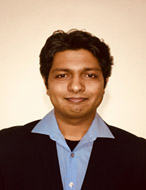 Dr. Sriram Ganeshan joined the CCNY Physics Department as an assistant professor in January 2018. He obtained his undergraduate degree in Physics from Sri Venkateswara College (Delhi University, India) in 2004 and Masters in Physics from Jawaharlal Nehru University (Delhi, India) in 2006. He then obtained his Ph.D. from Stony Brook University in 2012. After his Ph.D., Dr. Ganeshan held a postdoctoral position at the Joint Quantum Institute and Condensed Matter Theory Center at the University of Maryland, College Park (2012-2015). Prior to joining CCNY, he was a Research Assistant Professor at the Simons Center for Geometry and Physics at Stony Brook University (2015-2017).
Dr. Sriram Ganeshan joined the CCNY Physics Department as an assistant professor in January 2018. He obtained his undergraduate degree in Physics from Sri Venkateswara College (Delhi University, India) in 2004 and Masters in Physics from Jawaharlal Nehru University (Delhi, India) in 2006. He then obtained his Ph.D. from Stony Brook University in 2012. After his Ph.D., Dr. Ganeshan held a postdoctoral position at the Joint Quantum Institute and Condensed Matter Theory Center at the University of Maryland, College Park (2012-2015). Prior to joining CCNY, he was a Research Assistant Professor at the Simons Center for Geometry and Physics at Stony Brook University (2015-2017).
Professor Ganeshan’s research in Theoretical Condensed Matter Physics is focused on the diverse class of problems addressing quantum phases of matter: 1) Applying quantum field theory and hydrodynamic methods to the strongly correlated topological phases of matter such as fractional quantum Hall effect; 2) Disordered quantum systems, quantum chaos and quantum thermalization at the mesoscopic scale where quantum effects average toward an emergent classical behavior, but the underlying quantum fluctuations alter the expected classical outcomes significantly; and 3) Search for out-of-equilibrium quantum phases in driven-dissipative systems with no equilibrium analogs.
Myriam Sarachik Symposium Held
On November 27, 2018, Myriam Sarachik’s colleagues, collaborators, friends, research associates, students and admirers gathered at the Advanced Science Research Center (ASRC) on the South Campus of the City College of New York to celebrate her 85th Birthday and retirement.
After dedicated teaching, inspired research and devoted service for 54 years, during which she rose from an Assistant Professor to a Distinguished Professor of Physics and blazed many trails, Sarachik was retiring. She left an indelible imprint on condensed matter physics research, human rights, higher education and the status of women in science.
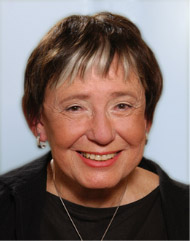 The symposium started with guest arrival and a social hour at the ASRC Lobby at 9.30 AM. Michael Lubell, Zemansky Professor of Physics at CCNY, opened the morning session and introduced the CCNY President Vincent Boudreau. President Boudreau welcomed the symposium attendees and paid homage to Sarachik’s struggles as a child to flee Nazi-occupied Belgium, to establish herself as a condensed matter physicist and educator in a male-dominated field and her many achievements in research and human rights.
The symposium started with guest arrival and a social hour at the ASRC Lobby at 9.30 AM. Michael Lubell, Zemansky Professor of Physics at CCNY, opened the morning session and introduced the CCNY President Vincent Boudreau. President Boudreau welcomed the symposium attendees and paid homage to Sarachik’s struggles as a child to flee Nazi-occupied Belgium, to establish herself as a condensed matter physicist and educator in a male-dominated field and her many achievements in research and human rights.
Sarachik worked on a number of different problems in condensed matter physics, human rights and served as President of the American Physical Society as well as on the National Academy Council. The symposium program was organized to have some of her collaborators and co-workers present short talks covering a majority of these areas. Gordon Thomas, a Distinguished Professor of Physics at the New Jersey Institute of Technology, mentioned the difficulties and discriminations that she had to face as a female physicist and how she overcame those in his talk “Still, She Persisted.” He also elaborated on her work on the metal-insulator transition in doped semiconductors. Jonathan Friedman, her former graduate student and now a Professor of Physics at Amherst College, then recounted their highly visible work on molecular magnets in his talk, “Myriam and (Nano)Magnets.” The last talk of the morning session was “Myriam & Me – Seeking Superconductivity,” by Morrel Cohen of Rutgers University.
CCNY Acting Dean of Science Parameswaran Nair opened the afternoon session with brief remarks on Sarachik’s contributions to the field of low-temperature condensed matter Physics. The talks in the afternoon session included: “From Doped Semiconductors to Astronomical Cameras to Life on Mars,” by Lucianne Walkowicz of Adler Planetarium, Library of Congress; “My Journey in Magnetism and Human Rights with Myriam,” by Eugene Chudnovsky of CUNY Lehman College; “To Tell the Truth: Science, Diplomacy and Lies,” by Irving Lerch of New York University and American Physical Society; and “Serving Together on the National Academy Council,” by Paul Falkowski of Rutgers University. These talks were followed by a tribute from CCNY Interim Provost Tony Liss. The floor was then opened for remarks from the symposium attendees. Many of Sarachik’s colleagues and former students made brief complimentary remarks, which were followed by closing remarks from Michael Lubell. A reception at the ASRC lobby after the talks enabled attendees to exchange greetings with the honoree and sign a memento.
Sarachik is widely recognized for her contributions. She is a Member of National Academy of Sciences (NAS), a Fellow of the American Academy of Arts and Sciences, a Fellow of the American Physical Society, a Fellow of the New York Academy of Sciences and a Fellow of the American Association for the Advancement of Science (AAAS). She is the recipient of the NYC Mayor's Award for Excellence in Mathematical, Physical and Engineering Sciences (1995), Sloan Public Service Award from the Fund for the City of New York (2004), APS Oliver E. Buckley Condensed Matter Physics Prize (2005) and L'Oreal/UNESCO Award "For Women in Science" for North America (2005). She was awarded an honorary Doctor of Science degree by Amherst College in 2006. After serving on numerous committees and as a Board member, she served as President of the American Physical Society in 2003. She is a member of the Governing Council of NAS and of the Council of the AAAS.
Faculty Accomplishments and Awards
Alfano wins SPIE Gold Medal
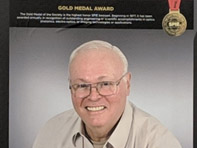 Distinguished Professor Robert Alfano is the 2019 recipient of the SPIE Gold Medal, the highest honor that the International Society for Optics and Photonics (SPIE) bestows. Professor Alfano was recognized for his “outstanding seminal achievements and contributions to advancement of knowledge on fundamental properties of materials and their interaction with light in areas of biology, condensed matter, semiconductors, tunable lasers and biomedical optics.” The award includes an honorarium of $10,000 and compensation of up to $2,000 for travel. Professor Alfano is the founder and Director of the Institute for Ultrafast Spectroscopy and Lasers and winner of many awards.
Distinguished Professor Robert Alfano is the 2019 recipient of the SPIE Gold Medal, the highest honor that the International Society for Optics and Photonics (SPIE) bestows. Professor Alfano was recognized for his “outstanding seminal achievements and contributions to advancement of knowledge on fundamental properties of materials and their interaction with light in areas of biology, condensed matter, semiconductors, tunable lasers and biomedical optics.” The award includes an honorarium of $10,000 and compensation of up to $2,000 for travel. Professor Alfano is the founder and Director of the Institute for Ultrafast Spectroscopy and Lasers and winner of many awards.
Ghaemi wins Google Quantum Innovation Award
 Dr. Pouyan Ghaemi, Assistant Professor of Physics, received the Quantum Innovation Award given by Google Quantum Hardware Laboratory. Ghaemi’s research proposal titled “Studies of fractional Hall effect using superconducting Qubits” earned him this award. Fractional Hall phases emerge due to strong electron-electron interactions in the Hall regime. In this proposal Ghaemi argued that by using superconducting Qubits one can model the electrons in Hall levels and tune their effective interactions to engineer desired fractional Hall phases and the quasi-particles with novel quantum statistics. The award includes a $10,000 grant to support proposed research efforts.
Dr. Pouyan Ghaemi, Assistant Professor of Physics, received the Quantum Innovation Award given by Google Quantum Hardware Laboratory. Ghaemi’s research proposal titled “Studies of fractional Hall effect using superconducting Qubits” earned him this award. Fractional Hall phases emerge due to strong electron-electron interactions in the Hall regime. In this proposal Ghaemi argued that by using superconducting Qubits one can model the electrons in Hall levels and tune their effective interactions to engineer desired fractional Hall phases and the quasi-particles with novel quantum statistics. The award includes a $10,000 grant to support proposed research efforts.
Vinod Menon chosen IEEE Photonics Society Distinguished Lecturer
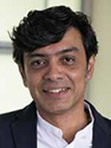 Professor Vinod Menon was chosen as one of the six IEEE Photonics Society Distinguished Lecturers for the year 2018-19. The Program was “designed to honor excellent speakers who have made technical, industrial or entrepreneurial contributions to the field of photonics and to enhance the technical programs of the IEEE Photonics Society Chapters,” the announcement from the Society says. The 2018-2019 Distinguished Lecturer term began July 1, 2018.
Professor Vinod Menon was chosen as one of the six IEEE Photonics Society Distinguished Lecturers for the year 2018-19. The Program was “designed to honor excellent speakers who have made technical, industrial or entrepreneurial contributions to the field of photonics and to enhance the technical programs of the IEEE Photonics Society Chapters,” the announcement from the Society says. The 2018-2019 Distinguished Lecturer term began July 1, 2018.
Hernan Makse on Predicting Structural Collapse in Mutualistic Ecosystems
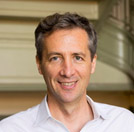 Collapses of dynamical systems into irrecoverable states are observed in ecosystems, human societies, financial systems and network infrastructures. Despite their widespread occurrence and impact, these events remain largely unpredictable. In searching for the causes for collapse and instability, theoretical investigations have so far been unable to determine quantitatively the influence of the structural features of the network formed by the interacting species. A team of physicists at CCNY led by Hernan Makse and Flaviano Morone has derived the condition for the stability of a mutualistic ecosystem as a constraint on the strength of the dynamical interactions between species and a topological invariant of the network: the k-core. Their solution that appeared in the October 22, 2018 issue of Nature Physics
Collapses of dynamical systems into irrecoverable states are observed in ecosystems, human societies, financial systems and network infrastructures. Despite their widespread occurrence and impact, these events remain largely unpredictable. In searching for the causes for collapse and instability, theoretical investigations have so far been unable to determine quantitatively the influence of the structural features of the network formed by the interacting species. A team of physicists at CCNY led by Hernan Makse and Flaviano Morone has derived the condition for the stability of a mutualistic ecosystem as a constraint on the strength of the dynamical interactions between species and a topological invariant of the network: the k-core. Their solution that appeared in the October 22, 2018 issue of Nature Physics
[https://www.nature.com/articles/s41567-018-0304-8] predicts that when species located at the maximum k-core of the network go extinct, as a consequence of sufficiently weak interaction strengths, the system will reach the tipping point of its collapse As a key variable involved in collapse phenomena, monitoring the k-core of the network may prove a powerful method to anticipate catastrophic events in the vast context that stretches from ecological and biological networks to finance.
Nicolas Yehya, Division of Science Valedictorian
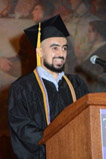 Nicolas Yehya, Physics major, was the Class of 2018 Division of Science valedictorian. He graduated from the Macaulay Honors College with research honors in Physics. He carried out his honors research on spectroscopic properties of supramolecular nanomaterials under the tutelage of Professor Dorthe Eisele. Nicolas was active in the Physics Club and was a member of the Student Executive Committee. He is pursuing his graduate studies in Molecular Biophysics at The Johns Hopkins University.
Nicolas Yehya, Physics major, was the Class of 2018 Division of Science valedictorian. He graduated from the Macaulay Honors College with research honors in Physics. He carried out his honors research on spectroscopic properties of supramolecular nanomaterials under the tutelage of Professor Dorthe Eisele. Nicolas was active in the Physics Club and was a member of the Student Executive Committee. He is pursuing his graduate studies in Molecular Biophysics at The Johns Hopkins University.
Undergraduate Students Receive Awards
The Physics Department gives out several awards and scholarships to undergraduate students every year. The awards for 2017-18 Academic Year were presented on May 3, 2018. Panaglotis Anastasiou received the Sidney Millman Scholarship that is presented to the junior Physics major demonstrating high potential. The Sonkin Medal was awarded to Rian Koots for demonstrating the best performance in the Physics laboratory course(s) and/or in experimental research. Ryan Lanzetta and Anastasia Spiridonova received the Ward Medal that is presented to the graduating physics major with the highest GPA in physics and mathematics courses. Nicolas Yehya is the recipient of the Bernard Hamermesh Scholarship, which recognizes the outstanding graduating Physics major, who has demonstrated some of the skills, knowledge, technique and imagination necessary for a successful Experimental Physicist and who shows promise of being an active contributor to the research efforts in some branch of Experimental Physics. Merna Youssef received the Dr. Jerry A. Gelbwachs Scholarship that is awarded to the Physics major demonstrating academic excellence and high potential to benefit society. The Martin A. Tiersten Scholarship recognizes the students with the highest performance in Mechanics (Physics 35100), and the recipient of the scholarship this year is Peter Fields. The Harry Soodak Scholarship, given to the outstanding junior physics major who wants to pursue a career in Physics went to Kevin Becker. Ryan Lanzetta received the Michio Kaku Award for Theoretical Physics which was given this year for the first time. It recognizes the outstanding graduating Physics major who has demonstrated some of the skills, knowledge, technique and imagination necessary for a successful Theoretical Physicist.
 The students graduating with Research Honors in Physics are Steven Alsheimer, Ethan Bendau, Christopher K. Chong, Rian Koots, Ryan Lanzetta, Anastasia Spiridonova, Nicolas Yehya, and Jason Yu.
The students graduating with Research Honors in Physics are Steven Alsheimer, Ethan Bendau, Christopher K. Chong, Rian Koots, Ryan Lanzetta, Anastasia Spiridonova, Nicolas Yehya, and Jason Yu.
The Zemansky Introductory Physics Prize recognizes outstanding scholarship in Introductory Physics 20700 or Physics 20800 courses. The students receiving the award in the 2017-18 academic year are: Hamaz Alawlaqi, Oren Ben-Meir, Andrew Betz, Yashoma Boodhan, Cindy Chee, Chieh-Huang Chen, Ethan Chiu, Louis Christopulos, Binod D.C., Ayoub Diouri, Alexandros Gloor, Simon Heimowitz, Yingjie Huang, Gazi Inkiyad, Daniel Jimenez, Eric Kolbusz, Alan Lau, Benjamin R. Margulies, Stefan Oppers, Amitesh Prabhudayal, Merrill Etienne Preska Steinberg, Naman Pujari, Stephen Riesenberg, Hira Tariq, Rublya Tasnim, Jia Hui Weng and Jonathon White.
Master’s Degrees in Physics 2018
This year six City College students received their Master’s degrees in Physics. In February, Mayra Vialette received her degree before beginning work with the Royal Bank of Canada where she had earlier been an intern. In June, there were five graduates: Henry Best, Thomas Brick, Richard Brun Jr., Richard Gozali, and Ahamed Jubair. Henry Best (who has already passed the doctoral qualifying exam) and Ahamed Jubair join the CUNY doctoral program in Physics this fall. Thomas Brick will continue his work in physics and plans to apply for doctoral graduate work later this year. Richard Brun is currently a research assistant at the Institute for Ultrafast Spectroscopy and Lasers at City College.
Recent Ph. D.’s
Inna Korzhovska defended her Ph. D. thesis, “Effects of Structural and Electronic Disorder in Topological Insulator Sb2Te3 Thin Films” for February 2018 degree. Professor Lia Krusin-Elbaum was her mentor.
Kate Burleson-Lesser’s Ph. D. thesis, "A Network Theoretical Approach to Real-world Problems: Application of the k-core Algorithm to Various Systems" was carried out under the supervision of Professor Hernan Makse. She defended on June 20 for September 2018 degree.
Amol A. Deshmukh defended his thesis, “Baryons and Interactions in Magnetic Fields,” to earn the degree in September 2018. Professor Brian Tiburzi was his mentor.
Jacob D. Henshaw’s thesis “Charge State Dynamics and Quantum Sensing with Defects in Diamond,” was conducted under the supervision of Professor Carlos Meriles. Dr. Henshaw is pursuing his postdoctoral research in the Meriles Group with a NSF fellowship.
Jesse S. Kanter received his Ph. D. in September 2018 for his thesis, “Quantum and Classical Transport of 2D Electrons in the Presence of Long and Short Range Disorder” carried out under the tutelage of Professor Sergey Vitkalov.
Shaojun Luo’s thesis, “Interdisciplinary Studies of Complex Network and Machine Learning and its Applications” leading to his Ph. D. degree was conducted under the supervision of Professor Hernán A. Makse.
Peter J. Schnatz defended his thesis, “Supercharged Models of Intrinsically Disordered Proteins and their Utility in Sensing,” in time to earn his degree in September 2018. Professor Ronald Koder was his adviser.
Distinguished Professor Myriam Sarachik supervised Qing Zhang’s thesis, “Direct Experimental Evidence of Toroidal Symmetry in a Lanthanum-Based Molecular Magnet.” Dr. Zhang received the degree in September 2018.
The department congratulates the new Ph. D.s and wishes them success in their future endeavors.
New Graduate Students
Graduate students in the Physics Ph.D. program, who decided to pursue their thesis research at CCNY starting in 2018 fall are: Sara Abedi (Vitkalov), Rezlind Bushati (Menon), Kai Chen, (Khanikaev, Electrical Engineering), Damon S. Daw (Meriles), Moyosore Odunsi (Shattuck), Jessica S. Rosenberg (Koplik), Salah E. Salah (des Georges, Chemistry) and Haozhen Wang (Xi Chen, Chem. Engineering). The names of respective mentors are included in the parentheses. The department extends warm welcome to these new Ph. D. students.
Remembering Harry Lustig
Ngee-Pong Chang
 “饮水思源 (Yinshui siyuan), when you drink from the stream, remember the source.” Chinese saying
“饮水思源 (Yinshui siyuan), when you drink from the stream, remember the source.” Chinese saying
In 1965, when I joined the CCNY physics department, the chairman, Harry Lustig, had just returned from his sabbatical in Ireland, and right away he launched into the project to submit a proposal to the National Science Foundation (NSF) for a $1 million Center of Excellence grant. As a department with Mark Zemansky and Henry Semat on the faculty, CCNY was already famous as a teaching institution. To convince the NSF that CCNY was ready for a Center of Excellence took effort and skill.
Well, the department was awarded the $1 million grant, but there was the question how to attract top talent to come to CCNY. Lustig did not settle for any but the best, and did not hurry to fill the appointments. In 1969, when Buell Gallagher, the Seventh president of CCNY stepped down, Lustig made a personal trip to Rochester, NY, to recruit Robert Marshak for the presidency. Marshak was already a member of the National Academy of Sciences, and founder of the international High Energy Physics Conference held at Rochester. Marshak joined CCNY as the Eighth president in 1970.
When Marshak came as president, the department was able to recruit Bunji Sakita as distinguished professor in 1970, followed by Melvin Lax in 1971 and Joseph Birman, Herman Cummins and Harry Sweeney in 1974. Sakita built a high-energy theory group, and brought in young Michio Kaku, Joe Lykken (Fermilab), Michael Dine (SLAC), Ernest Ma (UC-Riverside), Spenta Wadia (Tata Institute for Fundamental Research) and others.
Lustig became Dean of Science in 1972, and helped Marshak set up the Sophie Davis School of Biomedical Science, the Institute of Oceanography, and the Benjamin Levich Institute for Physico-Chemical Hydrodynamics.
But for me, the most memorable thing that Lustig did was to convince Arthur Tiedemann, Acting President after Marshak stepped down in 1979, to lead a CCNY delegation to China. In the summer of 1981, with David Cheng, Dean of Engineering, and Lustig, Dean of Science, CCNY was one of the first U.S. institutions to sign a Memorandum of Understanding for an exchange program with Chinese Academy of Sciences (CAS), Fudan University, Shandong University, Nanjing University, Northwest University and Zhongshan University. This was at a time when China had just opened the door to the West after Cultural Revolution, and Lustig was a visionary in building a bridge to China.
Lustig took the initiative to work with Sy Weissman, Director of CCNY Alumni Association, to start the CCNY Chinese Alumni Group in 1982, which today has broadened to become the CCNY Asian Alumni Group.
Under the Exchange program, we have had visiting scholars from the top CAS institutes in Beijing, from their High Energy Physics Institute, the Institute of Physics, and the Theoretical Physics Institute as well as senior visiting scholars from Fudan, Nanjing, Shandong and elsewhere. We had delegations from the presidents of our sister institutions in China, including K. C. Chou, the President of CAS, leading a delegation to visit CCNY.
CCNY also participated in the famous CUSPEA (China-US Physics Entrance Application) program started by Nobel laureate T. D. Lee of Columbia University, which continued even after 1989 on a smaller scale in the form of mini-CUSPEA that recruited first-class students from Fudan and Peking Universities. Among our graduates is Daxi Li, founder of Chinese Association for Science and Business (CASB).
But to come back to Lustig, after Marshak stepped down in 1979 and retired to Virginia Tech, Lustig wanted CCNY to remember Marshak’s contribution to the spectacular rise in stature of CCNY. He succeeded in navigating the CUNY Board politics, and convinced them to name the Science Building after Marshak even though he was not a rich donor. Lustig, thus, was very much a personification of yinshui siyuan.
He retired in 1986 to become Acting Executive Officer of American Physical Society (APS), and stayed on as APS Treasurer from 1987 to 1996. He died of prostate cancer on March 17, 2011 in Santa Fe, New Mexico.
As CCNY evolves to establish a new research center, build new laboratories and form new research groups of excellence, should we not take the time to consider yinshui siyuan and remember Lustig’s role in all these?
Upcoming Events
Day of Science
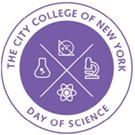 Thursday, April 11, 2019 is the City College of New York Inaugural Day of Science. The activities of the day will include lab tours and faculty presentations covering topics in Physics, Chemistry, Biology, Earth and Atmospheric Sciences, and Mathematics. Guests will also have the opportunity to visit selected research labs at the Center for Discovery and Innovation (CDI) building and the Marshak Science building, take a virtual tour of the cosmos at the CCNY Planetarium and view projects from the division of science biodiversity initiative.
Thursday, April 11, 2019 is the City College of New York Inaugural Day of Science. The activities of the day will include lab tours and faculty presentations covering topics in Physics, Chemistry, Biology, Earth and Atmospheric Sciences, and Mathematics. Guests will also have the opportunity to visit selected research labs at the Center for Discovery and Innovation (CDI) building and the Marshak Science building, take a virtual tour of the cosmos at the CCNY Planetarium and view projects from the division of science biodiversity initiative.
Cummins Lecture
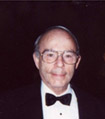 The fifth Hermann Z. Cummins Lecture is scheduled to be presented on April 24, 2019 by Dr. Jorg Wrachtrup, Professor of Physics and Director of Institute for Quantum Science and Technology, University of Stuttgart, Germany. The title of the talk is, “Nanoscale Quantum Sensing.”
The fifth Hermann Z. Cummins Lecture is scheduled to be presented on April 24, 2019 by Dr. Jorg Wrachtrup, Professor of Physics and Director of Institute for Quantum Science and Technology, University of Stuttgart, Germany. The title of the talk is, “Nanoscale Quantum Sensing.”
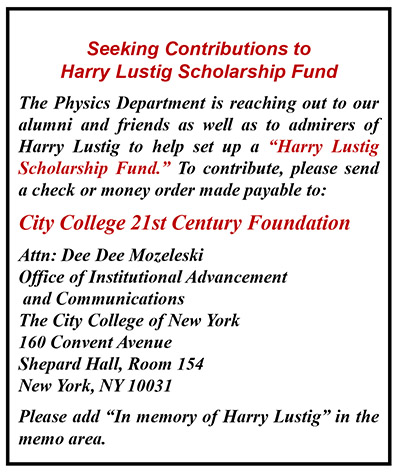
Last Updated: 06/06/2019 16:32